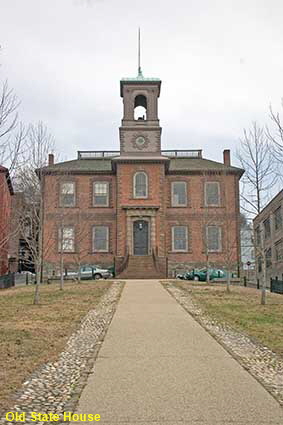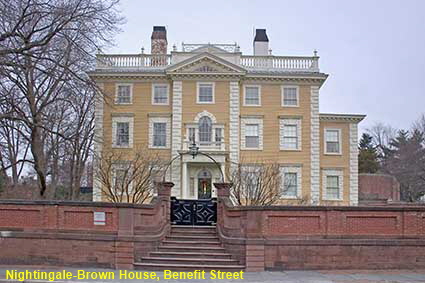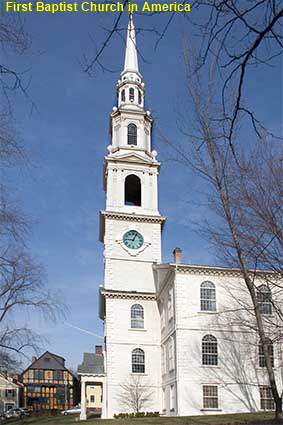Providence
In 1636 after he was banished by the Massachusetts Great and General Court, English clergyman Roger Williams left the Massachusetts Bay Colony and founded the settlement of Providence . He chose the name in gratitude for "God's merciful providence" that the Narragansett Indians granted him title to the site. Although it was the first settlement in what became Rhode Island, Providence was soon overshadowed by the seaport that sprang up at Newport. The railroad changed all that and in 1900 Providence became sole state capital. Unlike Newport, growth has given Providence a high rise ‘Down City’, but it still has a lot of history in the College Hill area, which we felt was woefully undersold.
Old State House
During Colonial times and the early days of the US, the capital of Rhode Island rotated between five towns. This means that Rhode Island has five old state houses in addition to the current one. The Old State House in Providence was built between 1760 and 1762, although shortage of funds delayed completion of fitting out of the interior continued until 1771. Built initially to a design very similar to Old Colony House in Newport, the building was extensively modified in the 19th century, including the addition of the tower. The changes have left it looking very like a typical provincial English town hall of the period. In addition to its rota use as a meeting place for the state’s General Assembly it also served as a Council Chamber and Courthouse.
Nightingale-Brown House, Benefit Street
Although the University has erected a few modern monstrosities, the area around College Hill still has many historic buildings. Benefit Street has so many that it is known as ‘The Mile of History’. The Nightingale-Brown house was built in 1792 for Captain Joseph Nightingale but was bought by Nicholas Brown in 1814. The house remained in the Brown family until 1979 when the widow and children of John Nicholas Brown set up a foundation named after him to encourage study and original research into American art, history, architecture, and historic preservation. In 1995 it became part of Brown University.
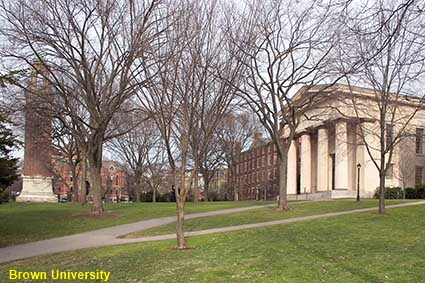
First Baptist Church in America
Clergyman Roger Williams not only founded Providence but in 1638 he also founded its Baptist congregation. The congregation initially met in houses until in 1700 a small Meeting House (church) was built. This was soon outgrown and in 1726 it was replaced with a larger one until that also was outgrown. The Baptist congregation of the First Baptist Church in America now worships in its third Meeting House but it can trace its history right back to Williams’ time and is therefore the oldest in the USA. The current Meeting House was designed by Joseph Brown and built between 1774 and 1775. The 56 metre (185 foot) high steeple was added shortly afterwards, the first on a Baptist Meeting House in New England, which for mariners approaching Providence proved to be a much appreciated aid to navigation.
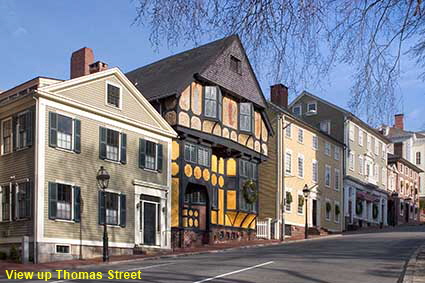
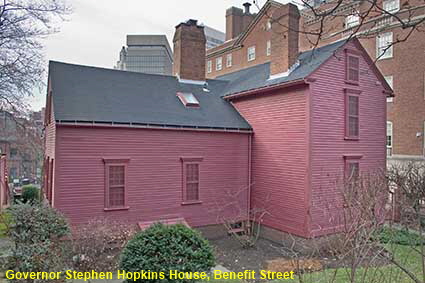
DLU060124
Click on Minimap to navigate
Home > US States > New England > Rhode Island >


To move forwards or backwards through the Rhode Island trail click the arrows above, or select your next destination on the Minimap.
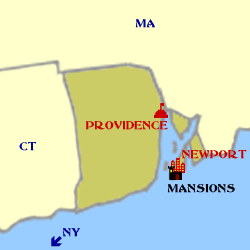
View up Thomas Street
On Thomas Street can be found buildings associated with Art and Literature rather than Commerce and Government. The yellow building second from the left is the Fleur-de-Lys Studio and the red brick building on the right is the Providence Art Club. The Fleur-de-lys Studio built by Sidney Richmond Burleigh in 1885 features in the book ‘The Call of Cthulhu’ by Providence born author Howard Phillips Lovecraft (1890 - 1937). The Providence Art Club was established in 1880 and in 1887 took over the 1790 Obadiah Brown House in Thomas Street. The Art Club now also owns the Fleur-de-Lys Studio.
Governor Stephen Hopkins House, Benefit Street
Low winter sun and a looming tower block made the view of the front of this building rather unattractive, so here is a side view. Part of the house is reputed to have been built in 1707, but in 1743 it was purchased by Stephen Hopkins and he had major additions made to the house. Hopkins was elected governor of Rhode Island 10 times, as well as being chief justice of the Superior Court, and Chancellor of Brown University. He was one of the two people who signed the Declaration of Independence on behalf of Rhode Island. With so many activities one wonders if he had any time left to entertain visitors, but apparently a certain George Washington did visit his house twice.
Brown University
Rhode Island College was founded in Warren in 1764 and in 1770 it moved to Providence. In 1804 the college was renamed Brown University in honour of manufacturer and philanthropist Nicholas Brown, the founder of Brown & Ives. The Manning Chapel on the right of this picture was built in 1834 at Brown’s expense. Like other Ivy League universities, Brown has its traditions. For example the main gates of the Van Wickle Gates to the grounds are opened only twice a year, once to let freshers in and again to let the graduates out. Mythology predicts failure for any undergraduate passing through the main gates.

© Mike Elsden 1981 - 2025
The contents of this page may not be reproduced in full or in part without permission
